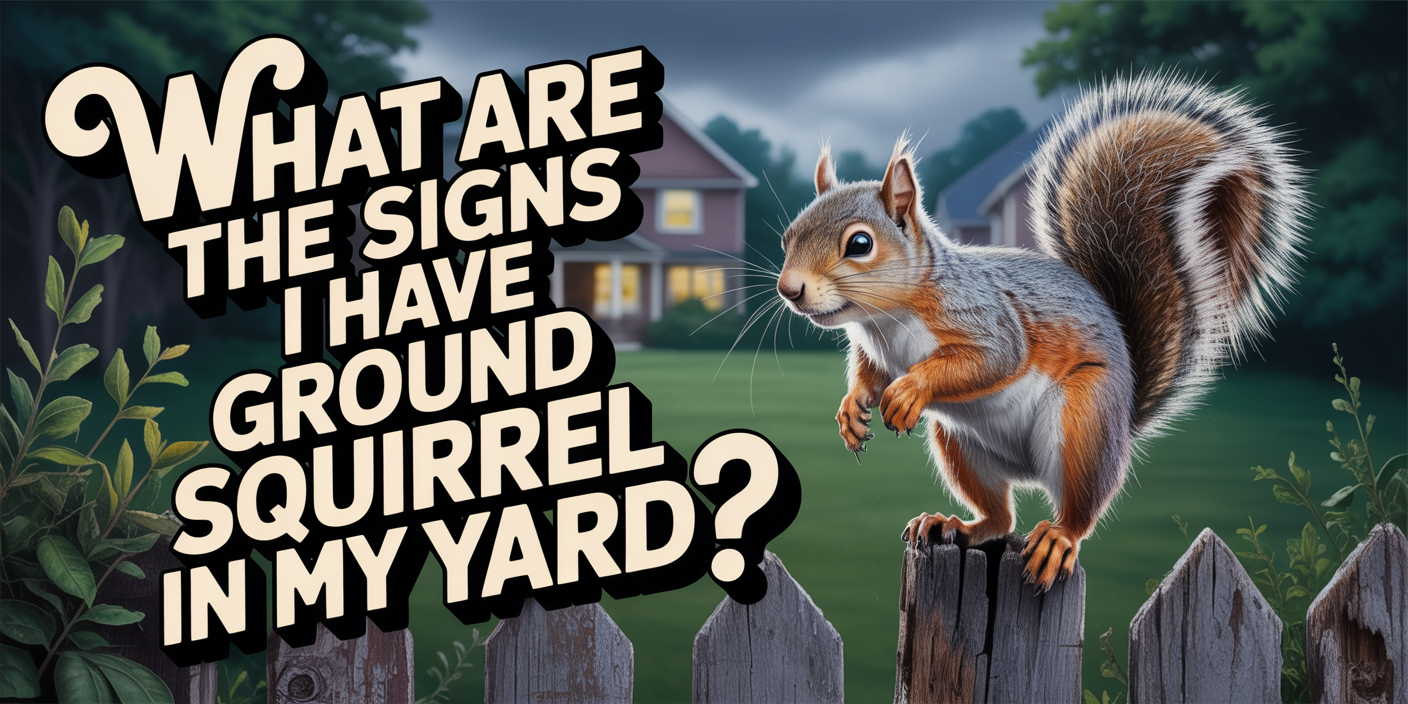You likely have ground squirrels in your yard if you’re seeing small round holes in the ground, loose dirt mounds, or chewed-up plants. Their burrows, daytime activity, and visible tracks are all clear signs these rodents have moved in
Ground squirrels may seem harmless at first glance, but their presence can quietly lead to serious problems in your yard. From ruined gardens to structural damage beneath patios or walkways, these burrowing pests often go unnoticed until the damage is already done.
Knowing the signs of ground squirrel activity early on gives you a chance to stop them before their colony grows. In this guide, we’ll break down exactly what to look for, why it matters, and when it’s time to call in the pros.
Visual Signs of Ground Squirrel Activity
Small Round Holes or Burrow Entrances
One of the most obvious signs of ground squirrels is the appearance of small, round holes in your yard—usually 3 to 5 inches wide. These entrances often lead to complex underground burrows used for nesting, storing food, and escaping predators.
You’ll typically find them near fences, garden beds, or open patches of grass where the soil is loose. Unlike mole or gopher holes, ground squirrel burrow entrances often lack significant mounding and are spaced several feet apart across a larger area.
Dirt Mounds and Soil Displacement
Ground squirrels leave behind scattered dirt or small mounds near the entrance of their burrows. These piles are created as they dig out tunnels and chambers underground, pushing the excess soil to the surface.
You may notice these mounds disrupting garden beds, lawn edges, or areas near patios and walkways. While they’re not as large as gopher mounds, they’re still a clear sign that something is tunneling beneath your yard.
Worn Tracks and Surface Trails
Ground squirrels often create visible runways or trails between their burrow entrances and food sources. These tracks can appear as narrow, flattened paths through grass, dirt, or even mulch, especially in yards with frequent squirrel activity.
Over time, these pathways become more defined as squirrels repeatedly travel the same routes throughout the day. If you spot multiple trails crisscrossing your yard—especially ones leading to gardens or feeding areas—it’s a strong indicator of an active squirrel colony.
Damage to Plants and Garden Areas
Gnawed Plants and Missing Garden Vegetables
Ground squirrels are voracious foragers that love digging up bulbs, munching on leafy greens, and nibbling fruits or flowers. If your garden suddenly has chewed stems, missing produce, or half-eaten flowers, it could be a clear sign these rodents are helping themselves.
They often target tender plants, roots, and low-growing vegetables like lettuce, beans, and strawberries. Unlike rabbits that usually clip plants cleanly, ground squirrels tend to leave ragged, uneven bite marks and may also scatter soil around as they dig.
Behavioral Clues You Can Observe
Daytime Squirrel Activity
Ground squirrels are diurnal, meaning they’re active during the daytime—especially in the morning and late afternoon. If you frequently see small, brownish-gray rodents darting across your yard or popping in and out of holes, you’re likely watching ground squirrels in action.
They often pause upright on their hind legs to scan for predators before diving back into their burrows. This behavior, combined with repeated sightings in the same areas, strongly suggests that a colony has taken up residence nearby.
Sudden Bursts Into Burrows
One distinctive behavior of ground squirrels is their quick, darting movements into nearby burrows when startled. If you see a squirrel disappear into the ground within seconds after spotting you, it’s a solid clue that you’ve found an active entrance.
This startle-and-hide pattern helps them evade predators like hawks, snakes, and neighborhood pets. Multiple instances of this behavior around your yard usually indicate a well-established burrow system just below the surface.
Unusual Sounds or Scents Around the Yard
While ground squirrels aren’t loud animals, you might occasionally hear soft rustling in dry brush, leaf piles, or under sheds and decks. During mating season or territorial disputes, you could also catch faint chirps or squeaky calls, especially in quieter areas of your yard.
In addition to sound, concentrated areas of burrows may develop a slightly musky or earthy scent, particularly near dense colonies. If you notice these subtle but unusual changes around garden beds or along fence lines, it could be a sign that ground squirrels are living nearby.
Lawn or Structural Damage
Ground squirrel burrows can weaken the soil beneath walkways, patios, and garden structures. Over time, you might notice soft or uneven spots in your lawn, sinking areas near foundations, or small collapses where the tunnels have undermined the ground.
If left unaddressed, these burrows can lead to more serious structural issues like cracked concrete, damaged irrigation lines, or unstable fencing. What starts as a small hole in the yard can quickly become a costly repair job when squirrels tunnel under built-up areas.
Why You Shouldn’t Ignore the Signs
Ignoring early signs of ground squirrel activity can lead to rapid colony expansion and escalating damage. A few burrow holes may not seem urgent, but ground squirrels reproduce quickly and their networks can grow out of control within weeks.
Beyond structural concerns, their presence can attract predators like snakes or coyotes to your yard. Plus, unchecked digging may disrupt landscaping, sprinkler systems, or even pose tripping hazards for pets and people. Taking action early helps you avoid a much bigger problem down the line
Stay Ahead of the Damage Before It Spreads
Ground squirrel problems don’t go away on their own—they only grow larger and more costly over time. Catching the signs early gives you the chance to act fast, protect your property, and avoid more serious repairs down the road.
Whether it’s a single burrow or a colony in the making, staying proactive is key. With the right approach and support from AAAC Wildlife Removal, you can stop the damage in its tracks and keep your yard safe, stable, and squirrel-free.
Let AAAC Wildlife Removal Handle It Professionally
Dealing with ground squirrels isn’t as simple as filling a hole or setting a trap—effective removal takes strategy, experience, and the right tools. At AAAC Wildlife Removal, we assess your property thoroughly, identify all active burrows, and design a humane plan that fits your specific situation.
We use proven exclusion methods, eco-friendly deterrents, and habitat restoration to keep squirrels out for good. From inspection to follow-up, our team ensures the problem is solved completely—so you don’t have to keep fighting the same battle every season.
Conclusion
Ground squirrels may be small, but the damage they cause can add up fast if you don’t take the right steps. Instead of relying on guesswork or risky DIY methods, trust solutions that are safe for your family, pets, and the environment.
Choosing a humane approach not only keeps your property intact—it also prevents harm to non-target wildlife and preserves your local ecosystem. With expert guidance and smart prevention, you can enjoy a squirrel-free yard without compromising your values.




